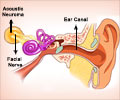Electrosurgery employed in the removal of tonsils and adenoids does not result in a compromise of the integrity of the cochlear implant device, a new study has found.
Electrosurgery employed in the removal of tonsils and adenoids does not result in a compromise of the integrity of the cochlear implant device, a new study has found. The findings of the present study could eventually pave way for a safe, maximal pain-free and effective method to remove tonsils and adenoids in deaf children.
Cochlear implant (CI) recipients have been discouraged from having monopolar electrosurgery for ear, nose, and throat procedures due to concerns over possible damage to the implant and the auditory neurons. While monopolar electrosurgery is rarely, if ever, absolutely necessary, it greatly facilitates treatment in certain procedures such as adenoidectomy. With a growing population of patients receiving CIs at very young ages, more children with CIs may subsequently develop a need for an adenoidectomy, such as obstructive sleep apnea. Unfortunately, no published studies have evaluated the safety of electrosurgical adenoidectomy in CI reipients.Over the past few years, radiofrequency bipolar electrosurgery (eg, Coblation™) has become popular for adenoidectomy and tonsillectomy because of reports of less post-tonsillectomy pain. The reduction in post-tonsillectomy pain has been attributed to the more limited spread of electrical current and reduced tissue temperatures with Coblation bipolar electrosurgery relative to monopolar electrosurgery. The more limited current spread with Coblation electrosurgery would theoretically impart less risk to a CI and the auditory neurons. As with other electrosurgical techniques, no studies have reported the safety of Coblation adenoidectomy in CI recipients.
Twelve frozen 40 – 50 pound pigs and 12 cochlear implants with superficial defects were used for the experiment. After thawing the pigs, the cochlear implants were placed unilaterally via a standard transmastoid approach. Saline was infiltrated into the cochlea and middle ear to ensure contact between the electrode and surrounding tissues, then the wound was closed with running locked silk suture.
Nasopharyngeal Electrosurgery: The palate and posterior wall of the nasopharynx were treated with either monopolar electrocoagulation or Coblation bipolar electrosurgery. Both were applied with continuous saline irrigation to ensure maximum electrical conduction. The monopolar cautery unit was set at 50, which is double the energy level typically used for adenoidectomy at our institution, and applied for 15 minutes; radiofrequency bipolar electrosurgery was performed using the Coblator II system. The duration of Coblation treatment was doubled to 30 minutes because of the inability to double the intensity of treatment beyond its maximum level of 9, as was done with the monopolar electrosurgical treatment. This yielded a total of 270 J with Coblation treatment.
Cochlear Implant Integrity Assessment: Implants underwent standard integrity checks by the manufacturer prior to shipping and after electrosurgery. These evaluations included open circuits, device electronics, ability of the device to function at normal levels, and stability of stimulation delivered by each channel. The manufacturers were blinded to the treatment group. Immediately prior to and after subjecting the animals to electrosurgery, ‘clinical’ telemetry was performed on each device by the respective manufacturer’s technical staff to ensure proper functioning of the device in situ.
Intraoperative telemetry revealed normal impedances and device integrity in all of the cochlear implants with the exception of the fifth Nucleus 24 CI, treated with electrocautery, which demonstrated an open electrode #15, both pre and post electrosurgery. Manufacturer testing revealed no additional abnormalities in any of the cochlear implants exposed to either monopolar or Coblation electrosurgery.
Advertisement
The researchers believe that their observations should be viewed as merely a first step toward establishing the safety of various electrosurgical technologies for head and neck procedures, such as adenoidectomy, and they should be recognized as not being necessarily directly reflective of the human condition. They suggest that in the absence of definitive high level evidence (i.e., controlled trials) to guide treatment decisions, lower level evidence must be used to guide treatment. On a theoretical level, Coblation should be safer than monopolar electrosurgery, because the former involves bipolar current passing through tightly approximated electrodes on the end of the electrosurgical wand, whereas monopolar current may spread in a much more diffuse pattern from the nasopharynx to the grounding pad. Unlike other forms of electrosurgery, there are no reports on the safety of Coblation electrosurgery with other implantable stimulators, such as pacemakers and cardiac defibrillators.
Advertisement










